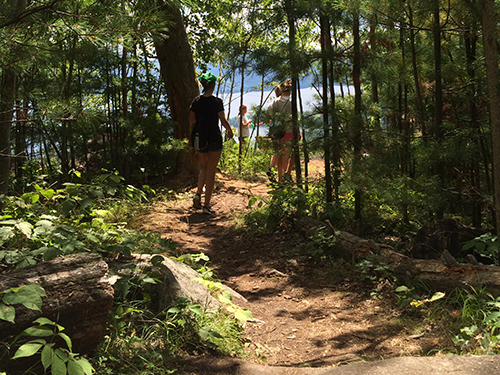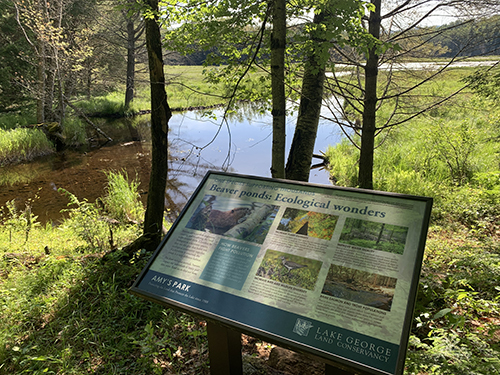Getting Started
There are lots of resources online, just be sure you’re looking at recent information. If you find someone who, for instance, writes a great review of their family’s hike at Amy’s Park in 2018, their experience may be very different from what you’d find today because the trails and parking lots have changed since then.
It’s also best to get your information straight from the source—get the newest brochures and trail details here. In addition to trail info, you’ll also learn that our preserves are open year-round, dawn to dusk, and that some preserves are open to hunting and other activities.

BUILD TO CHALLENGES
Nothing ruins a hike like taking on something too difficult or too long, especially if you have kids in tow. If you are new to hiking, go easy, even if you’re in good physical shape. Get comfortable with the basics of hiking before you add in the challenges that come with steep climbs and more remote locations.

Bring a printed map with you, and know how to read it. You may have a map on your phone, but don’t assume that you’ll have cell service.
Always carry water and high energy snacks, even for a short trek—low blood sugar and dehydration can sneak up on you.
Protect your feet! For many easy and moderate trails, sturdy sneakers are fine, but avoid sandals or other shoes you wouldn’t wear with socks.
A general rule of thumb is it takes 30 minutes to hike an easy 1 mile trail. This varies widely depending on the physical fitness of those in your group. Bring enough food and water for the duration, and bring a flashlight just in case it takes longer than expected.
Hiking Guidelines
FOLLOW THE TRAIL
This may seem straightforward, but if you’ve never been on a trail before, it may seem daunting to know where to go.
Each LGLC preserve has a kiosk, usually at the main parking area. The kiosks have maps and paper brochures (while we try to keep these stocked, it’s still best to come prepared in case they’re all gone). There is also a register, or log-in book. It’s always a good idea to write your name, date, time, and number of people you’re with, in case of an emergency. It also helps us know how many people use our preserves each year.
From there you should see the first trail marker on a tree. These are colorful plastic circles; they could be red, yellow, blue, orange, white, or green. Sometimes we use other markers, such as yellow triangles, or even a swatch of paint on the tree. One marker tells you to continue straight. Two markers indicate a turn, according to the top marker’s position (left or right of the bottom one). There may also be arrows or other directional signs to help you along the way.
Follow these markers like a dot-to-dot, until you reach your destination—a scenic overlook, waterfall, pond, picnic spot, etc. Avoid taking “shortcuts” through the woods; trails are created with intention of reducing impact on the plants and soils. At any point that you need to rest or get a drink, do it! Stop and take a look around while you catch your breath.
LEAVE NO TRACE
There are Seven Principles of Leave No Trace, and all aim to minimize human impact on the environment. These include some commonsense guidelines of not leaving trash behind, respecting wildlife, and being considerate of others on the trail. For a full list and more advice on hiking, go to LNT.org.
PUBLIC USE GUIDELINES FOR LGLC PARKS & PRESERVES
Please respect the following guidelines while visiting any of the LGLC’s parks and preserves:
- All properties are open year-round, dawn to dusk.
- Please stay on the marked trails.
- Please be courteous of other preserve guests.
- No removal of plants or animals without permission.
- The LGLC allows hunting by permit only at select properties. Please visit our hunting page for more information.
- Please use caution when hiking during hunting seasons – wear bright colors and hike in groups. Hunters – please be aware of hikers and hunt away from trails. Please follow NYS DEC’s Hunting Safety Rules. Click here to go to NYS DEC’s Hunting website.
- No camping, littering or fires.
- Motorized or non-motorized recreational vehicles are NOT allowed.
- Leashed dogs are permitted, but please clean up after your dog. Do not leave plastic dog waste bags on site.
- Please park only in the designated area.
- To report trail damage or maintenance issues, please email stewardship@lglc.org or call 518-644-9673.
For properties owned by the NYS DEC, the following rules apply:
- Please follow DEC State Land Camping and Hiking Rules when visiting.
- Hunting is permitted according to New York State regulations.
- Please use caution when hiking during hunting seasons – wear bright colors and hike in groups. Hunters – please be aware of hikers and hunt away from trails. Please follow NYS DEC’s Hunting Safety Rules. Click here to go to NYS DEC’s Hunting website.
- To report any problems or acquire any permits, please contact DEC Forest Ranger Rick Schroeder at 518-335-3888 or the DEC Regional Office at 518-897-1300. For emergencies, call 518-891-0235.
SPRING HIKING
As the days get longer and this wonderful sunshine melts the snow and ice off the ground, it can be tempting to head out to your favorite trail. However, please consider the fact that the thawing ground needs time to drain off and absorb all of that melting snow and get solid again before it can welcome your boots safely and sustainably.
If you do head out, make sure you are prepared for what may lay ahead – muddy, slippery trails. Choose trails that are designed with erosion and water control in mind, like our Schumann Preserve at Pilot Knob. Wear waterproof boots so you can stay on the trail regardless of its muddiness; avoid walking around wet areas to minimize damage to the surrounding vegetation and soil.
For more tips on hiking during mud season, check out this post from Leave No Trace, or DEC’s page about Spring Recreation Tips. Thank you for helping us keep our trails, and the watershed, healthy!
WINTER HIKING
Winter hiking requires additional preparedness before heading out to a trail. NYS Department of Environmental Conservation (DEC) has a page devoted to winter hiking safety, including how to layer for cold weather hikes, how to pack and prepare for winter hikes, and how to recognize and avoid hypothermia. Visit NYS DEC’s Winter Hiking Safety page.
In addition, please be aware that not all parking areas are plowed in winter.
- The LGLC does NOT plow its northern preserves: Cook Mt, Sucker Brook Preserve (Gull Bay/Last Great Shoreline), Leeming Jelliffe Preserve, Anthony’s Nose.
- NYS DEC Pole Hill Pond Preserve in Bolton is not regularly plowed.
![]()
American Hiking Society: Hiking 101
AHS provides tips in a number of categories, including outdoor skills, gear, safety and first aid, and discussions on issues related to hiking and outdoor recreation.
American Hiking Society: Hiking with Kids
Also brought to you by AHS, these are a few tips on what to bring and how to be prepared to bring your kids on their first hike.
Adirondack Mountain Club
Adirondack-specific information on where to go and what to expect when you get there.
Email Sarah at shoffman@lglc.org or call 518-644-9673.
Protecting the land that protects the lake since 1988. The Lake George Land Conservancy is an accredited not-for-profit land trust dedicated to working with willing landowners and other partners to protect the world-renowned water quality of Lake George and to permanently preserve the natural, scenic, historical and recreational resources of the Lake George Region.
-
18 March, 2024 No comment


